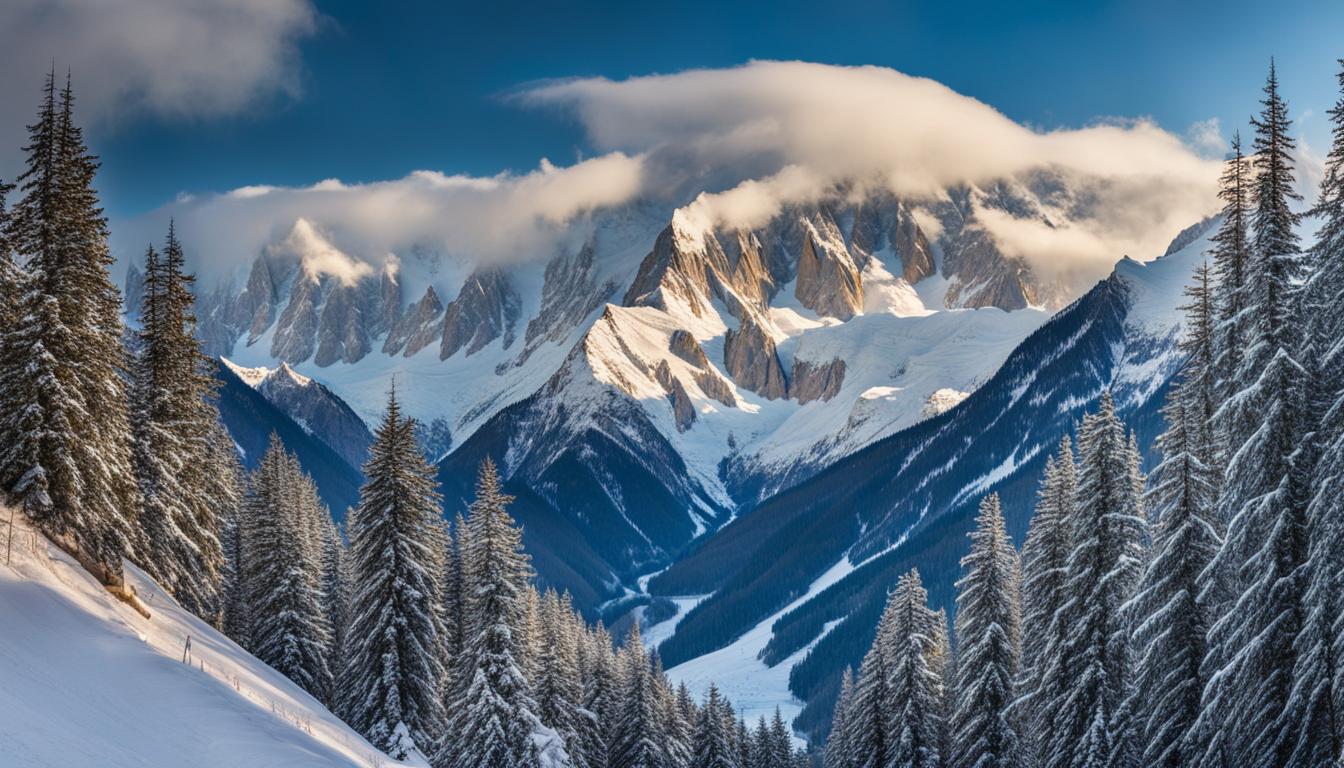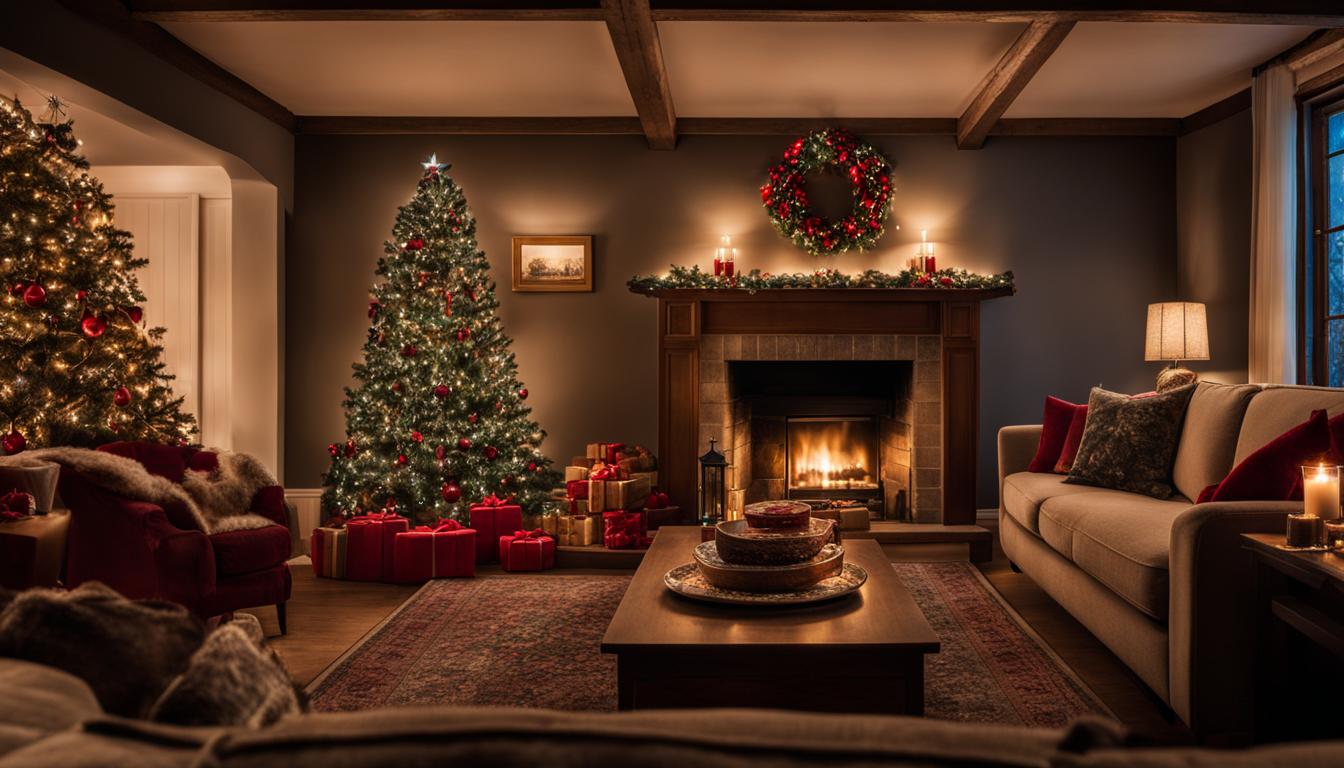Le Mont Blanc, also known as Mont Blanc, is Europe’s highest peak and offers a majestic mountain experience. With its stunning beauty and adventurous opportunities, it is a must-visit destination for nature lovers and outdoor enthusiasts.
As you stand in awe of its towering presence, Mont Blanc beckons you to explore its rugged terrain and experience the exhilaration of being surrounded by breathtaking landscapes. Whether you are a seasoned hiker, a mountaineer seeking a challenge, or simply someone who appreciates the wonders of nature, Mont Blanc offers something for everyone.
Key Takeaways:
- Le Mont Blanc, known as Mont Blanc, is Europe’s highest peak.
- Mont Blanc offers stunning beauty and adventurous opportunities.
- It is a must-visit destination for nature lovers and outdoor enthusiasts.
- Whether you are a seasoned hiker or a mountaineer, Mont Blanc has something for everyone.
- Prepare for an unforgettable adventure amidst the awe-inspiring landscapes of Mont Blanc.
Best Hotels Near Mont Blanc: Comfort and Convenience
If you’re planning a visit to Mont Blanc, it’s essential to find the best hotels that offer comfort and convenience for your stay. These hotels provide easy access to the mountain and ensure that you have a relaxing and enjoyable experience in the surrounding area. Whether you’re seeking luxury accommodations or budget-friendly options, there are a variety of hotels near Mont Blanc to suit your needs.
Here are some top hotel recommendations for your stay near Mont Blanc:
- Hotel Mont-Blanc Chamonix: Situated in the heart of Chamonix, this historic hotel offers stunning views of Mont Blanc and combines traditional charm with modern amenities. With a range of room options and on-site facilities such as a spa, restaurant, and bar, it’s an ideal choice for those seeking comfort and luxury.
- Hôtel Les Granges d’en Haut: Located in Les Houches, this boutique hotel offers a peaceful and picturesque setting with panoramic views of the mountains. The spacious rooms and chalets are designed with alpine-inspired decor, providing a cozy and comfortable atmosphere. Guests can also enjoy the hotel’s wellness center, outdoor hot tub, and delicious regional cuisine.
- Hotel Aiguille du Midi: Situated in the heart of Chamonix, this charming hotel offers easy access to the Aiguille du Midi cable car and breathtaking views of the surrounding mountains. The cozy rooms are tastefully decorated and equipped with modern amenities. Guests can also enjoy the hotel’s restaurant and bar, which serve delicious local cuisine.
These are just a few examples of the best hotels near Mont Blanc. It’s important to research and compare different options based on your preferences and budget. Whether you choose to stay in Chamonix, Les Houches, or other nearby towns, these hotels will provide a comfortable and convenient base for your Mont Blanc adventure.
| Hotel Name | Location | Rating | Price Range |
|---|---|---|---|
| Hotel Mont-Blanc Chamonix | Chamonix | 5 stars | $$$ |
| Hôtel Les Granges d’en Haut | Les Houches | 4 stars | $$ |
| Hotel Aiguille du Midi | Chamonix | 3 stars | $ |
Table: Best Hotels Near Mont Blanc
How to Reach Mont Blanc: Getting There Made Easy
Reaching Mont Blanc is made easy with various transportation options available. Whether you’re flying in or prefer a scenic drive, there are convenient ways to access this majestic mountain.
By Air
The closest airport to Mont Blanc is Geneva Airport in Switzerland, approximately 90 kilometers away. From there, you can take a bus or hire a private transfer to reach Chamonix, the main gateway to Mont Blanc. The journey usually takes around an hour and offers breathtaking views of the surrounding landscape.
By Car
If you prefer the flexibility of driving, you can reach Chamonix by car. The town is well-connected with major highways, making it easily accessible from various European cities. Keep in mind that during peak tourist seasons, the roads can be crowded, so plan your journey accordingly. Once in Chamonix, you can park your car and explore the area on foot or use the local transportation services.
By Train
Another scenic option is to take a train to Chamonix. The town is served by regular train services from major cities such as Geneva, Paris, and Milan. The journey offers stunning views of the Alps and is a convenient and environmentally friendly way to reach Mont Blanc. Once in Chamonix, you can take advantage of the local transport network to explore the region.
| Transportation Option | Travel Time |
|---|---|
| Air | Approximately 1 hour from Geneva Airport to Chamonix |
| Car | Varies depending on the starting location and traffic conditions |
| Train | Approximately 4-5 hours from Paris to Chamonix |
Once in Chamonix, there are cable cars and lifts that can take you closer to the mountain. These offer breathtaking views and easy access to hiking trails and other outdoor activities in the Mont Blanc region. Plan your journey well in advance and check for any travel restrictions or requirements before your trip to ensure a smooth and enjoyable experience.
The Tour du Mont Blanc: An Unforgettable Trek
The Tour du Mont Blanc is a popular trek that takes you through three countries – France, Italy, and Switzerland – in just over a week. It offers a diverse and stunning route, allowing you to experience the beauty of the Mont Blanc massif from different angles. The trek covers approximately 170 kilometers and includes highlights such as the valleys of Chamonix, Miage, and Les Contamines, as well as visits to Lac Blanc and the Col de Bonhomme. It is a challenging but rewarding adventure for hiking and trekking enthusiasts.
The Tour du Mont Blanc offers a unique experience to explore the stunning landscapes and rich cultural heritage of the Mont Blanc region. As you hike through picturesque valleys and ascend challenging mountain passes, you will be rewarded with breathtaking views of glaciers, alpine meadows, and towering peaks. Each day brings new adventures and encounters with fellow trekkers from around the world, creating a sense of camaraderie and shared accomplishment.
Along the route, you will have the opportunity to stay in charming mountain huts or cozy hotels, enjoying warm hospitality and hearty meals. These accommodations provide a comfortable base for rest and rejuvenation after a day of challenging trekking. You can also take advantage of the local cuisine, indulging in delicious regional specialties and sampling the flavors of the alpine culture.
| Route | Distance | Duration |
|---|---|---|
| TMB Classic | 170 km | 7-10 days |
| TMB Light | 100 km | 4-6 days |
| TMB Ultra | 200 km | 10-14 days |
Before embarking on the Tour du Mont Blanc, it is crucial to be well-prepared physically and mentally. The trek includes steep ascents and descents, exposed sections, and unpredictable weather conditions. It is recommended to have prior hiking experience and train to build endurance and strength. Carrying appropriate gear, including sturdy hiking boots, waterproof clothing, and a reliable backpack, is essential for a safe and comfortable journey.
The Tour du Mont Blanc is an adventure of a lifetime, offering an immersive experience in the captivating beauty of the Mont Blanc region. Whether you choose to complete the full circuit or opt for shorter sections, you will be rewarded with unforgettable moments and a deeper connection with nature. Lace up your hiking boots, follow the trail markers, and embark on this epic trek to discover the wonders of the Tour du Mont Blanc.
The Beauty of Chamonix: Gateway to Mont Blanc
Chamonix is a charming town nestled in the heart of the French Alps and serves as the gateway to Mont Blanc, Europe’s highest peak. With its picturesque beauty, abundant recreational opportunities, and rich cultural heritage, Chamonix is a popular destination for nature lovers and adventure enthusiasts.
One of the main attractions of Chamonix is its stunning alpine landscapes. Surrounded by towering peaks and majestic glaciers, the town offers breathtaking views that will leave visitors in awe. Whether you are an avid hiker, a passionate skier, or simply enjoy immersing yourself in nature’s beauty, Chamonix provides endless opportunities to explore and appreciate the natural wonders of the Mont Blanc region.
In addition to its natural beauty, Chamonix also offers a range of amenities and facilities for visitors. The town boasts a wide selection of accommodations, from cozy chalets to luxury hotels, ensuring that travelers of all budgets can find suitable options. The streets of Chamonix are lined with charming cafes, restaurants serving exquisite French cuisine, and boutique shops selling local crafts and souvenirs.
Outdoor Activities in Chamonix
Chamonix is renowned for its outdoor activities, making it a paradise for adventure seekers. In the summer months, visitors can embark on exhilarating hikes along well-marked trails that lead to stunning viewpoints and breathtaking alpine lakes. The Mont Blanc massif offers a range of climbing routes for both beginners and experienced mountaineers, providing a unique opportunity to test your skills in a challenging alpine environment.
During the winter season, Chamonix transforms into a winter wonderland, attracting skiers and snowboarders from around the world. With its extensive ski areas and diverse terrain, Chamonix offers something for everyone, from gentle slopes for beginners to thrilling off-piste descents for the more adventurous. Additionally, the town hosts annual winter sports events, including the prestigious Freeride World Tour, which showcases the talents of top athletes in extreme skiing and snowboarding.
Whether you are seeking a peaceful retreat in nature, an adrenaline-fueled adventure, or a blend of both, Chamonix is the perfect destination. With its breathtaking landscapes, wide range of activities, and charming town atmosphere, it truly represents the beauty and allure of the Mont Blanc region.
Hiking in the Dolomites and Zugspitze: Alpine Adventures
Hiking in the Dolomites and Zugspitze is a dream come true for outdoor enthusiasts seeking alpine adventures. These majestic mountain ranges offer breathtaking landscapes, exhilarating hikes, and unique cultural experiences. Whether you’re an experienced hiker or a beginner looking to explore the beauty of the Alps, the Dolomites and Zugspitze have something to offer for everyone.
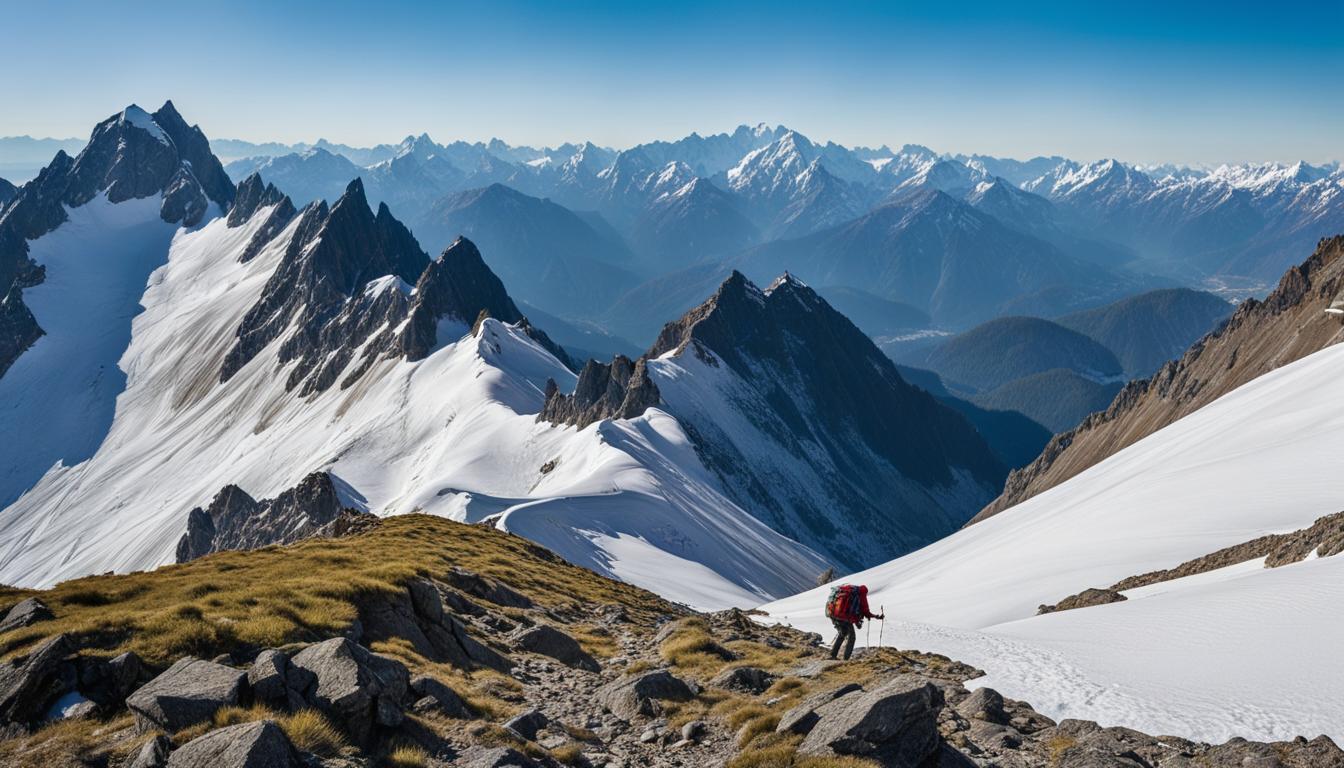
The Dolomites in Italy are renowned for their stunning limestone peaks, rugged cliffs, and picturesque alpine villages. This UNESCO World Heritage Site boasts a network of well-marked trails that cater to hikers of all levels. From gentle strolls along panoramic routes to challenging multi-day treks, there are endless opportunities to immerse yourself in the beauty of the Dolomites. Don’t miss the chance to visit iconic spots like Tre Cime di Lavaredo, Seceda, and Lake Braies, where the natural beauty will leave you in awe.
The Zugspitze, located in Austria and Germany, is Germany’s highest mountain and offers a unique alpine experience. A scenic train ride will take you to the summit, where you’ll be rewarded with breathtaking panoramic views of the surrounding peaks. From there, you can embark on various hiking trails that cater to different fitness levels, or even try your hand at mountaineering. The Zugspitze offers a fantastic blend of natural beauty, alpine adventure, and cultural exploration.
Both the Dolomites and Zugspitze provide a range of amenities, including well-equipped mountain huts and charming alpine towns, where you can rest and refuel after a day of hiking. Immerse yourself in the local culture, savor traditional cuisine, and learn about the rich history of these regions. Whether you choose to explore the Dolomites or conquer the Zugspitze, you’re in for an unforgettable alpine adventure.
Innsbruck: The Capital of Tirol
Innsbruck, located in the heart of Tirol, is a historic city that offers a perfect blend of culture and natural beauty. With its stunning alpine scenery and rich heritage, it attracts visitors from around the world. The city is known for its architectural gems, such as the iconic Golden Roof and the impressive Bergisel Ski Jump, which played a significant role in the Winter Olympic Games.
For those seeking cultural experiences, Innsbruck has a range of museums and palaces that showcase the region’s history and art. The Imperial Palace, Ambras Castle, and the Tyrolean State Museum are among the must-visit attractions. The city also hosts various events and festivals throughout the year, celebrating music, theater, and traditional customs.
Innsbruck’s natural surroundings provide endless opportunities for outdoor activities. From hiking in the nearby mountains to skiing in world-class resorts, there is something for everyone. The Nordkette mountain range, accessible by a modern cable car, offers breathtaking panoramic views of the city and the surrounding peaks. In winter, the area transforms into a winter wonderland, attracting skiers and snowboarders from all over.
“Innsbruck is a captivating city that combines history, nature, and adventure. Whether you’re strolling through the charming old town, exploring the Alpine landscapes, or indulging in delicious Tyrolean cuisine, Innsbruck will leave you enchanted.” – Traveler’s Review
With its unique blend of nature and culture, Innsbruck is a vibrant city that truly embodies the essence of the Alpine region. Whether you’re a history buff, an outdoor enthusiast, or a food lover, Innsbruck offers a captivating experience that will leave a lasting impression.
| Things to Do in Innsbruck | Where to Stay | Best Time to Visit |
|---|---|---|
|
|
|
Exploring South Tirol: Enchanting Landscapes
South Tirol, also known as Südtirol or Alto Adige, is a region in northern Italy that captivates visitors with its enchanting landscapes and rich cultural diversity.
Surrounded by the stunning peaks of the Italian Alps, South Tirol offers a wide range of outdoor activities for nature enthusiasts. Hike through picturesque valleys, conquer challenging mountain trails, or cycle along scenic routes. The region’s diverse terrain provides opportunities for all levels of adventurers.
But South Tirol is more than just a paradise for outdoor enthusiasts. It is a place where the Italian and Austrian cultures merge, creating a unique atmosphere. Explore charming towns and villages, where you can experience a blend of Italian and Tyrolean traditions, taste delicious local cuisine, and discover the region’s rich history.
Whether you seek awe-inspiring landscapes, cultural immersion, or thrilling outdoor adventures, South Tirol has something for everyone. Plan your journey to this enchanting region and be prepared to be mesmerized by its beauty and charm.

Notable Attractions in South Tirol
South Tirol is home to several remarkable attractions that showcase the region’s natural and cultural heritage. Here are a few notable highlights:
- Messner Mountain Museum: Located in several unique locations throughout South Tirol, this museum offers a fascinating exploration of mountaineering and the relationship between humans and mountains.
- Castles and Fortresses: Discover the region’s medieval history by visiting its impressive castles and fortresses, such as Tyrol Castle and Sigmundskron Castle.
- The Dolomites: A UNESCO World Heritage site, the Dolomites are a stunning mountain range renowned for their unique rock formations and breathtaking panoramic views.
- Wine Road: South Tirol is famous for its vineyards and excellent wines. Follow the Wine Road and explore charming wine villages, where you can taste a variety of local wines.
Outdoor Activities in South Tirol
South Tirol offers a plethora of outdoor activities that allow visitors to fully immerse themselves in the region’s natural beauty. Here are some popular activities:
- Hiking and Trekking: Choose from a wide range of hiking trails that cater to different skill levels and preferences. Explore the legendary Alta Via routes or embark on day hikes to enjoy the stunning alpine scenery.
- Mountain Biking: Ride along scenic mountain trails and experience adrenaline-pumping descents on purpose-built mountain bike trails.
- Skiing and Snowboarding: In winter, South Tirol transforms into a winter wonderland with numerous ski resorts offering a variety of slopes for skiers and snowboarders of all levels.
- Adventure Sports: For thrill-seekers, South Tirol offers activities such as rock climbing, paragliding, and canyoning.
With its captivating landscapes, rich cultural heritage, and an abundance of outdoor adventures, South Tirol is an ideal destination for those seeking an enchanting and memorable experience in the heart of the Italian Alps.
Aiguille du Midi: A Spectacular Ride
One of the most incredible experiences in the Mont Blanc region is taking the cable car to Aiguille du Midi. This iconic attraction offers a spectacular ride to the summit, providing breathtaking views of the surrounding peaks and glaciers. The Aiguille du Midi cable car is one of the highest in the world, reaching an altitude of 3,842 meters.
From Aiguille du Midi, visitors can step into the Void, a glass box suspended over a 1,000-meter drop. This thrilling experience allows you to feel like you’re floating in the air while admiring the stunning panorama. The views from the summit are truly awe-inspiring, with snow-capped peaks stretching as far as the eye can see.
“The cable car ride to Aiguille du Midi was a once-in-a-lifetime experience. The feeling of being suspended in the air and surrounded by majestic mountains is indescribable. The view from the summit is absolutely breathtaking, and stepping into the Void was a thrilling adrenaline rush. It’s a must-visit attraction for anyone visiting Mont Blanc!”
Table: Aiguille du Midi Facts and Figures
| Altitude | 3,842 meters |
|---|---|
| Location | Mont Blanc massif, French Alps |
| Opening Hours | 8:30 AM – 4:30 PM (subject to change depending on weather conditions) |
| Duration of Cable Car Ride | Approximately 20 minutes |
| Attractions | Panoramic views, step into the Void |
The cable car to Aiguille du Midi is a must-visit attraction for those who want to experience the awe-inspiring beauty of the Mont Blanc region. Whether you’re an adrenaline seeker or simply love breathtaking landscapes, this spectacular ride is sure to leave a lasting impression. Remember to check the opening hours and weather conditions before planning your visit to ensure the best experience possible.
Mont Blanc Weather: Prepare for Your Adventure
When planning a visit to Mont Blanc, it is crucial to be aware of the unpredictable and ever-changing weather conditions in the region. The mountain’s altitude, as well as its location within the French Alps, can significantly affect the weather patterns, making it essential for outdoor enthusiasts to be well-prepared.
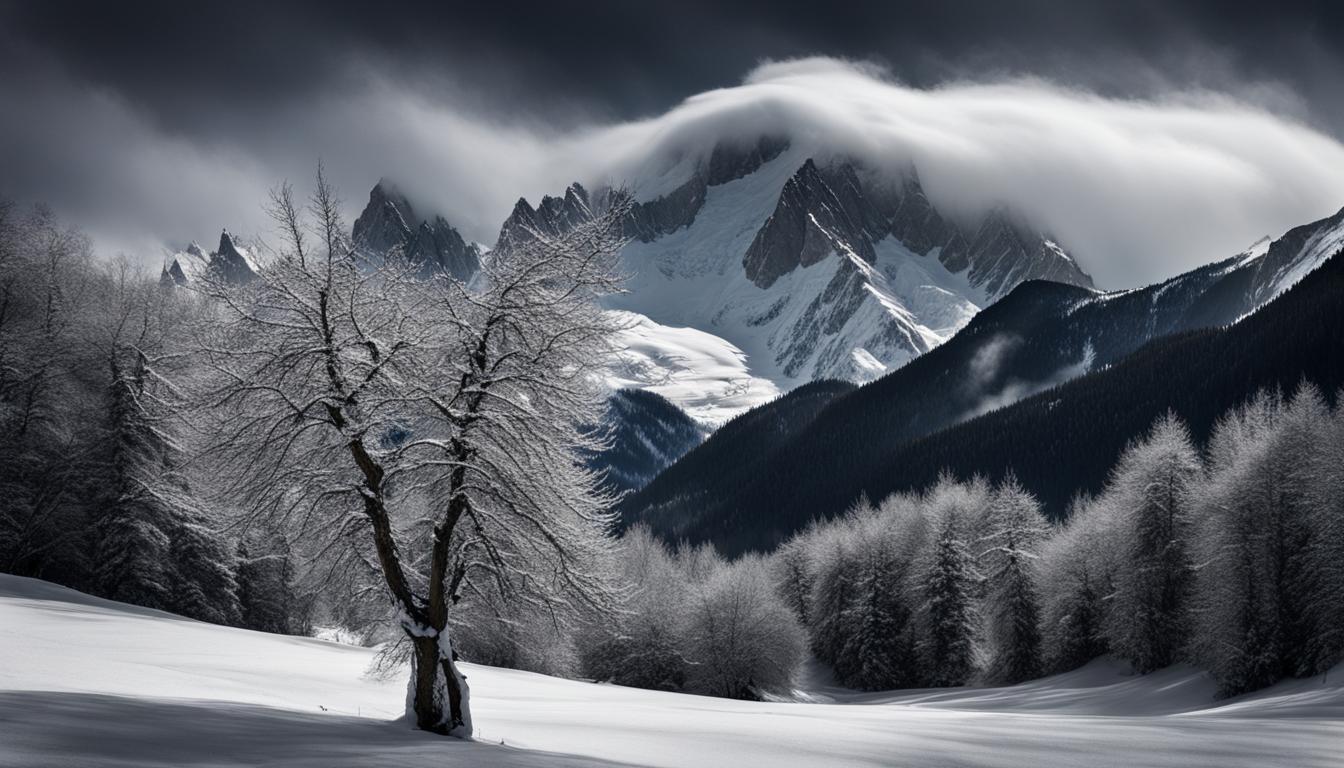
One of the most important steps in preparing for your Mont Blanc adventure is to regularly check the weather forecast. This will give you a better understanding of what to expect during your exploration and allow you to adjust your plans accordingly. Keep in mind that weather conditions can vary greatly at different altitudes, so it is advisable to check forecasts for different elevations as well.
When it comes to clothing and equipment, it is crucial to dress in layers and have the appropriate gear for various weather conditions. This includes a waterproof and windproof outer layer, warm insulating layers, gloves, a hat, and sturdy hiking boots. It is also recommended to carry a backpack with essentials such as water, snacks, a compass, a map, a headlamp, a first aid kit, and an emergency blanket.
For those considering hiking or climbing Mont Blanc, it is advisable to hike with a knowledgeable guide or join organized tours. Guides have the expertise to navigate the terrain and are familiar with the weather patterns, ensuring your safety and enhancing your overall experience. They can also provide valuable insights and local knowledge about the mountain and its surroundings.
Key Takeaways:
- Regularly check the weather forecast for Mont Blanc and its different elevations to plan your adventure effectively.
- Dress in layers and equip yourself with appropriate gear for changing weather conditions, including waterproof and windproof clothing, warm insulating layers, gloves, a hat, and sturdy hiking boots.
- Carry a backpack with essential items such as water, snacks, a compass, a map, a headlamp, a first aid kit, and an emergency blanket.
- Hike with a knowledgeable guide or join organized tours to enhance safety and experience the mountain more fully.
Mont Blanc Climbing: Conquer the Summit
If you are an experienced mountaineer seeking a new challenge, Mont Blanc offers the opportunity to conquer its majestic summit. Climbing Mont Blanc is a significant achievement that requires technical skills, physical fitness, and proper acclimatization. The ascent to the summit involves crossing glaciers, navigating crevasses, and dealing with changing weather conditions, making it a demanding and exhilarating adventure.
Before attempting to climb Mont Blanc, it is crucial to hire a certified guide who is familiar with the routes and experienced in guiding climbers. A knowledgeable guide will ensure your safety and help you navigate the challenges of the mountain. They will also provide valuable advice on training, equipment, and acclimatization.
Climbing Mont Blanc is a multi-day expedition that requires careful planning and preparation. It is recommended to train extensively in the months leading up to the climb, focusing on endurance, strength, and altitude acclimatization. Proper equipment, including crampons, ice axes, and mountaineering boots, is essential for safety and efficiency on the mountain.
Reaching the summit of Mont Blanc is a rewarding experience that offers breathtaking views and a sense of accomplishment. However, it is important to remember that climbing Mont Blanc is a serious undertaking that should not be underestimated. Proper training, preparation, and guidance are essential for a safe and successful climb. If you are up for the challenge, Mont Blanc awaits.
Table: Recommended Equipment for Mont Blanc Climbing
| Equipment | Description |
|---|---|
| Crampons | Ice traction devices that are attached to your boots for walking on glaciers and icy slopes. |
| Ice Axe | A versatile tool used for balance, self-arrest, and cutting steps on steep terrain. |
| Mountaineering Boots | Sturdy boots designed for climbing and walking on the mountain, providing support and insulation. |
| Rope | Used for safety and protection during glacier crossings and steep sections. |
| Harness | A safety system that attaches you to the rope and allows for easy movement on the mountain. |
| Helmet | Protects your head from falling rocks and ice, essential for safety in the mountains. |
| Warm Clothing | Layered clothing to protect against cold temperatures and changing weather conditions. |
| Food and Water | High-energy snacks and hydration systems to sustain you during the climb. |
“Climbing Mont Blanc is not just conquering a mountain; it’s a journey of self-discovery and pushing your limits. The beauty and challenge of the mountain will test you both physically and mentally, but the reward of reaching the summit is indescribable.” – Experienced Mountaineer
Mont Blanc Routes: Choose Your Path
When it comes to climbing Mont Blanc, there are several routes to choose from, each with its own unique characteristics and level of difficulty. Whether you’re an experienced mountaineer or a novice looking for a thrilling challenge, there’s a route that will suit your skills and aspirations. Here are some of the popular Mont Blanc routes to consider:
Gouter Route
The Gouter Route is the most popular and frequently climbed route to the summit of Mont Blanc. Starting from the Aiguille du Gouter, it traverses the Dome du Gouter and the Bosses Ridge before reaching the summit. This route requires mountaineering skills and experience, as it involves steep slopes, exposed ridges, and sections of rock and ice climbing. It is a challenging and demanding route that requires proper acclimatization and fitness.
Trois Monts Route
The Trois Monts Route is another popular option for climbing Mont Blanc. It starts from the Aiguille du Midi and involves traversing three major peaks – Mont Blanc du Tacul, Mont Maudit, and Mont Blanc itself. This route offers a more technical and challenging ascent, with mixed terrain of rock, ice, and snow. It requires good mountaineering skills and experience in glacier travel and alpine climbing.
Cosmiques Route
The Cosmiques Route is a less crowded alternative to the Gouter and Trois Monts routes. It starts from the Cosmiques Hut and follows a scenic traverse across the Tacul and Maudit glaciers before joining the Trois Monts route. This route offers stunning views and a less demanding climb, making it suitable for climbers with intermediate mountaineering skills.
Before attempting any of these routes, it is crucial to assess your climbing experience, physical fitness, and technical skills. Mountaineering in the Mont Blanc region is a serious undertaking that requires proper preparation, including acclimatization, training, and equipment. It is also recommended to hire a certified guide who can provide guidance, support, and ensure your safety throughout the climb.
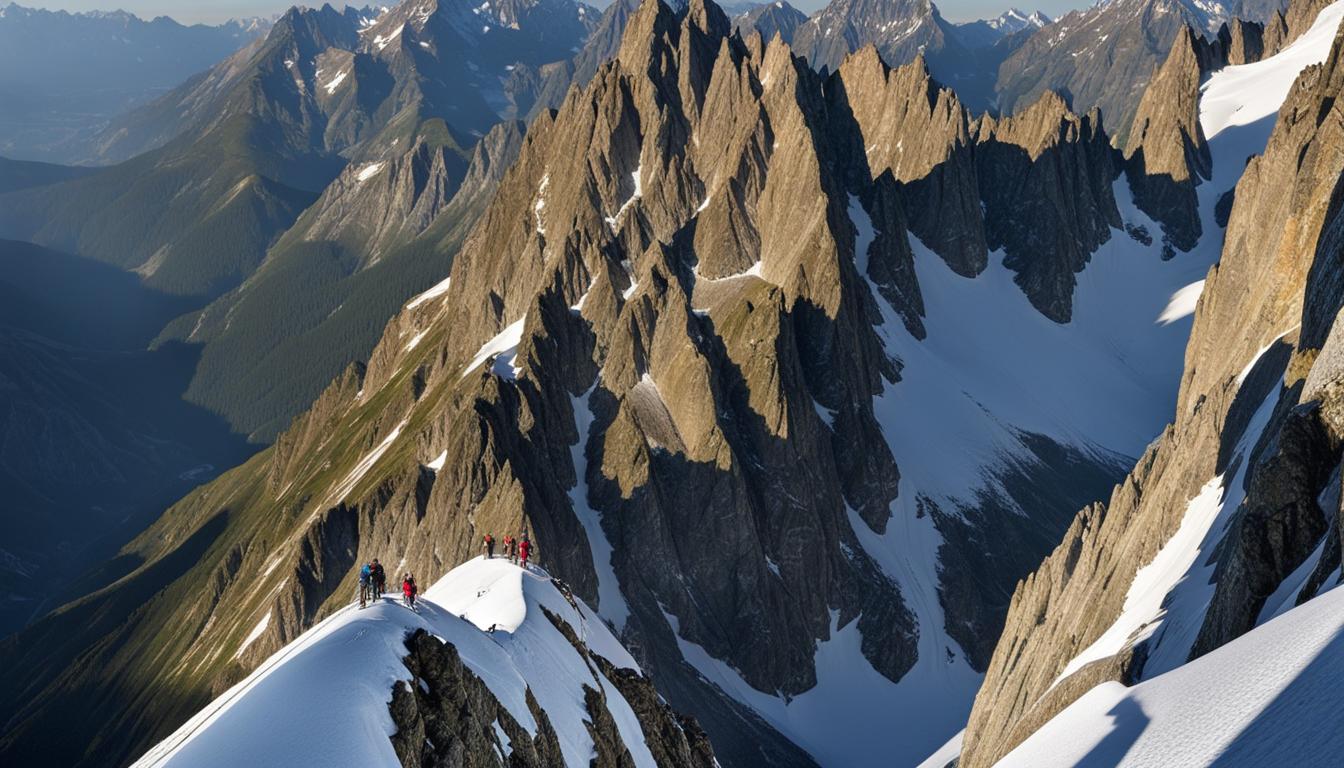
Mont Blanc: A Majestic Mountain Experience
Mont Blanc, also known as Le Mont Blanc, is a majestic mountain in Europe that offers a truly unforgettable experience for outdoor enthusiasts. With its breathtaking beauty, challenging hiking trails, and thrilling opportunities for mountaineering, Mont Blanc attracts adventurers from around the world.
For those who love hiking, Mont Blanc provides a wide range of trails that cater to different skill levels. From leisurely day hikes to the Tour du Mont Blanc, a multi-day trek that takes you through three countries, there are options for everyone. The diverse landscapes, including valleys, lakes, and glaciers, make each hike a unique and awe-inspiring adventure.
For the more experienced climbers, conquering the summit of Mont Blanc is a significant achievement. The climb requires technical skills, physical fitness, and proper acclimatization, but the reward is the breathtaking view from the summit and the sense of accomplishment that comes with reaching the highest peak in Europe.
Conclusion
In conclusion, Mont Blanc offers a majestic mountain experience that is sure to captivate nature enthusiasts and adrenaline seekers alike. With its awe-inspiring beauty, challenging hiking trails, and opportunities for mountaineering, Mont Blanc is a destination that promises thrilling experiences and unforgettable memories.
Whether you choose to tackle the Tour du Mont Blanc, explore the surrounding landscapes on day hikes, or admire the beauty from the Aiguille du Midi, there is something for everyone in this breathtaking region.
Plan your adventure today and immerse yourself in the awe-inspiring environment of Mont Blanc. With excellent accommodation options and transportation access, it is easy to plan your trip and make the most of your time in this majestic mountain paradise.
FAQ
What is the highest peak in Europe?
The highest peak in Europe is Le Mont Blanc, also known as Mont Blanc.
Why is Mont Blanc a must-visit destination?
Mont Blanc offers stunning beauty and adventurous opportunities, making it a must-visit destination for nature lovers and outdoor enthusiasts.
Are there hotels near Mont Blanc?
Yes, there are several excellent hotels near Mont Blanc that offer comfort and convenience for visitors.
How can I reach Mont Blanc?
Mont Blanc can be reached by various transportation options, including flying to the closest airport in Geneva, Switzerland, and then taking a bus or private transfer to Chamonix, the main gateway to Mont Blanc.
What is the Tour du Mont Blanc?
The Tour du Mont Blanc is a popular trek that takes you through three countries – France, Italy, and Switzerland – in just over a week. It covers approximately 170 kilometers and offers a diverse and stunning route.
What is Chamonix known for?
Chamonix is a charming town located in the French Alps and serves as the gateway to Mont Blanc. It is known for its picturesque beauty and popularity among outdoor enthusiasts.
Are there any other mountain ranges for hiking in the Alpine region?
Yes, the Dolomites in Italy and the Zugspitze in Austria and Germany offer incredible hiking opportunities in the Alpine region.
What is Innsbruck known for?
Innsbruck is known for its stunning alpine scenery, cultural attractions, and outdoor activities, such as hiking and skiing.
What is South Tirol known for?
South Tirol is known for its enchanting landscapes, cultural diversity, outdoor activities, and delicious local cuisine.
What is the Aiguille du Midi?
The Aiguille du Midi is a peak in the Mont Blanc range and offers a cable car ride to its summit, providing spectacular views of the surrounding peaks and glaciers.
What should I consider regarding the weather in the Mont Blanc region?
The weather in the Mont Blanc region can be unpredictable and change rapidly, so it is essential to be prepared and check the weather forecast regularly before heading out for any outdoor activities.
Can I climb Mont Blanc?
Climbing Mont Blanc is a significant achievement for experienced mountaineers and requires technical skills, physical fitness, and proper acclimatization.
Are there different routes to the summit of Mont Blanc?
Yes, there are several routes to reach the summit of Mont Blanc, each with its own level of difficulty and characteristics.
Why should I visit Mont Blanc?
Mont Blanc offers a majestic mountain experience with its awe-inspiring beauty, challenging hiking trails, and opportunities for mountaineering.


